|
|
|
|
A fresh look at taper rates for
butt-cut logs – Scott
Dodson, Vaagen Bros Lumber, Colville,
Washington. Scott reviewed the statistics that
he gathered
on taper rates for various species and diameter classes of butt-cut
logs
delivered to the Vaagen mill in Colville Washington
(NE part of USFS
Region 6).
Scott showed that the scanning on the merchandiser uses 3d (X-Y)
profiles which
accurately measures diameters every 4” and also measures
crook and sweep, and
thus is very accurate for assessing taper rates. The upshot of
Scott’s finding
was that USFS Region 6 taper rules used for butt-cut logs significantly
overstates the log volume in this region (Northeastern
Washington). Scott also discussed the findings of the
taper study
in nearby Idaho (Region
1) which closely matched the taper rates that they found in their
study. Scott requested that the USFS (which sets the standard for
scaling
rules) review taper in the area to come to their own conclusion. Click
here to view Scott's presentation on the merchandiser log
scaling, and here
to see the data on taper in butt-cut logs.
|
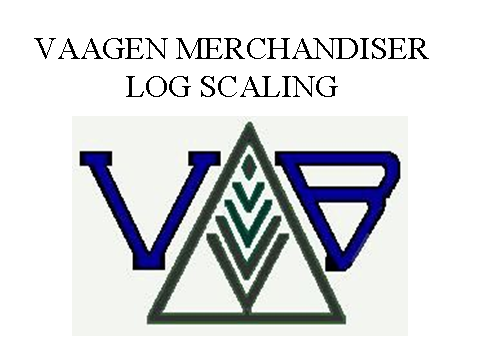
|
Review of various measurement
methods in the pulpwood
industry around the world – Christian Paccot, Director, Woodtech
Measurement
Solutions, Santiago, Chile. Christian
presented the various methods of measuring pulp logs from around the
world. He
outline the methods of measure of pulp, mainly stacked measure but also
hand
scale and weight. He showed that stacked measure can be manipulated by
the way
logs are stacked. He showed that logs down for 6 weeks can lose up to
25% of
the weight (depending on weather conditions and species). The pros and
cons of
each method was discussed and these included wood sample, to establish
oven dry
weight, and water submersion weight measure. View the presentation.
|
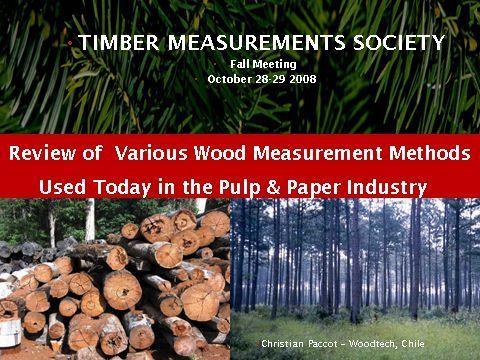
|
|
Managing and measuring Port Orford
Cedar – Ken
Lovelady, Sierra
Pacific Industries, Redding, California. Ken
discussed the natural range of Port Orford cedar
(POC), which is limited to the Northwest California and Southwest
Oregon. The tree resembles red cedar and yellow cedar, however the wood
is very light and has a pleasant smell (although it can be quite strong
and even create respiratory problems in some people). Unfortunately, a
root fungus is
slowly killing off this species in
much, if not all, of its range. Ken said that POC prices used to be
$8,000-$20,000/mbf but now are much less given the apparent loss of Japan’s
market
for this wood which had spiritual significance for many Japanese. He
mentioned
that it is sometimes difficult for some scalers to differentiate this
species
from incense cedar, however the wood tends to be much lighter in color,
has a
powerful and unique smell, and the intercept point between outer and
inner park
is much different when sliced into. He also mentioned that Port Orford
cedar
does not have the characteristic pecky rot of incense cedar, however,
it will
have center rot on occasion. To learn more about Port Orford Cedar click here.
|
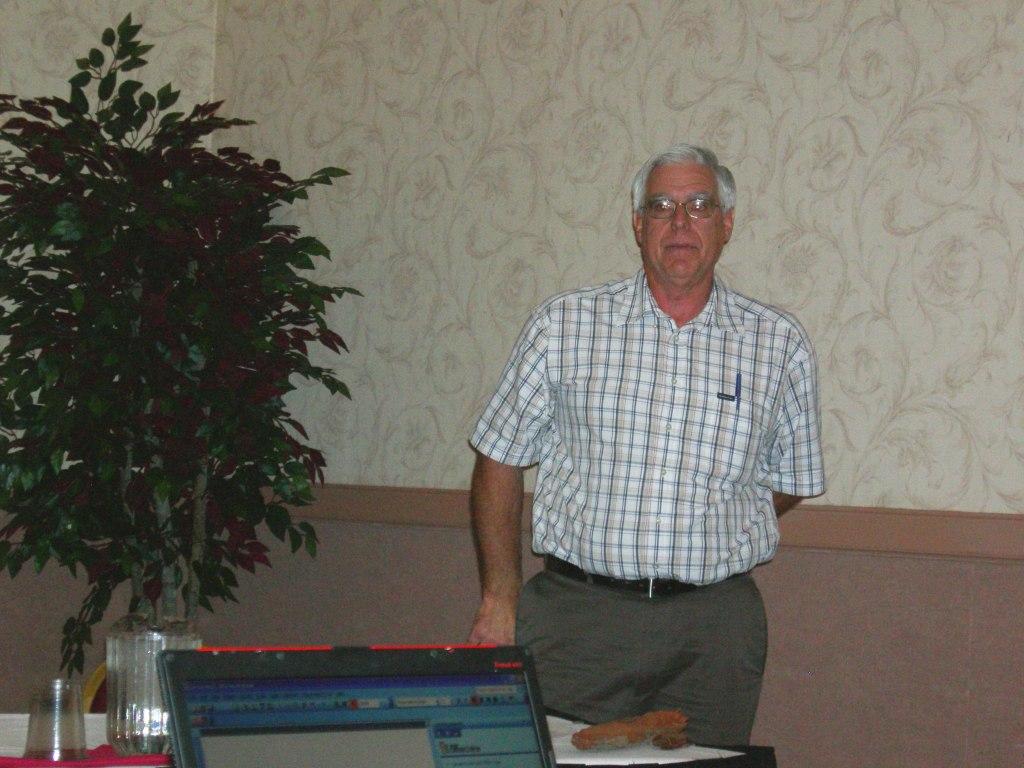
|
|
How
to select the best sampling system for
different types of timber cruise stands – Jon Aschenbach, Resource Supply,
LLC., Tigard, Oregon. Jon
discussed the various types of sampling systems used and why one
uses one system vs. another. If one picks the wrong sampling system,
you might
get the wrong answer even if all measurements are done perfectly. Jon
provided
a key to picking the best sample system, which he was quick to point
out is
just a guideline as all systems have their strength and weaknesses. The
main
point being, one has to look at the particular aim of the cruise, the
stand
type, whether acreage
can be accurately determined, etc., in order to assess
the best method. This should be done before any field work is attempted. View the presentation.
|
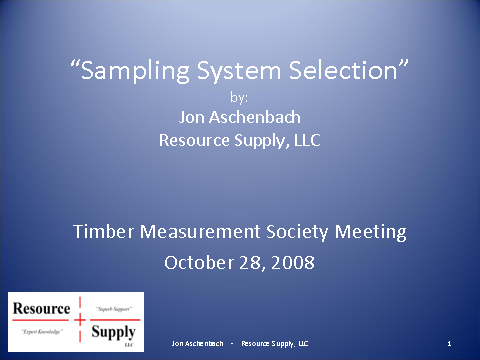
|
Logmeter
4000: An example of whole-load scanning
technology applied to Wood Measurement – Christian Paccot,
Director, Woodtech
Measurement Solutions, Santiago, Chile. He showed the products that they
developed for
Arauco and other companies. Their scanner is designed to be driven
through by a
logging truck and the scanners and software measures log attributes
such as log
diameters, length, and straightness. This system can measure over 900
truck
loads a day. The system uses the attributes of the outside (visible)
logs to
extrapolate the attributes of the inside logs. For pulp about 20% of
the logs
are visible and for sawlogs about 40-60% are visible. The new lasers
that they
are using are 30 times more intense than the old and produce
images
as detailed as a photo. Most of the mills are + or – 3%, 95%
of the time. There
are two models to measure logs and one to measure chips. Part A
of the presentation; Part B.
|
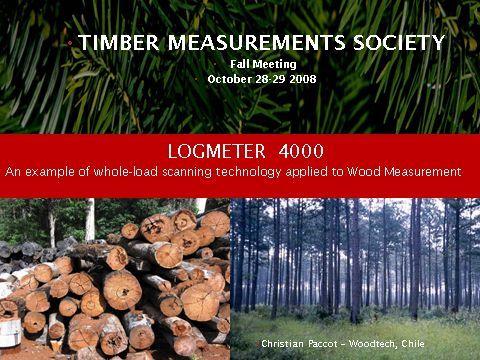
|
|
Measuring the volume of chip piles,
bark piles, and hog fuel with
Laser Rangefinders and MapSmart software – Jon Aschenbach, Resource
Supply,
LLC., Tigard, Oregon. Jon
mentioned several different methods of measuring chip piles.
Historically,
stock piles have been measured via an estimate, pacing, GPS, or Laser
range-finders. Using
a laser rangefinder with a built-in compass is ideal for
measuring stock piles. This type of laser rangefinder needs some
additional
care when used in close proximity to metal (such as a pulp mill etc.).
The Impulse laser
rangefinder can be used with an angle encoder and is therefore not
subject to
attraction to metal objects. The advantages of both of these systems is
cost;
in that one can relatively easily measure the displaced volume of a
pile and
they are significantly less expensive than an aerial measurement with
LIDAR.
Both systems utilize the MapSmart software from Laser Technology to
establish
displaced volume and accuracy levels are within + or - 5% of
engineering
standards. View the presentation.
|
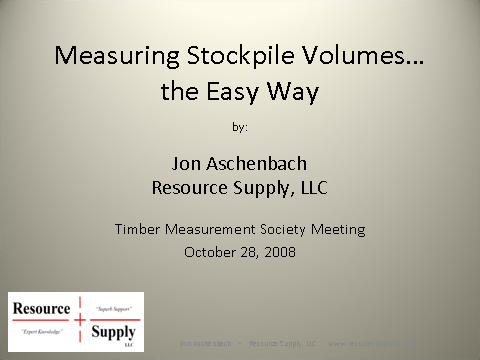
|
Getting the most out of measuring
logs: adding value
to an already valuable job – Clifford Lengstorf, Plum
Creek Timber Company, Columbia Falls, Montana. Cliff outlined additional values
that can be obtained
from scalers. These included gathering more information about the logs
such as
grade, attributes, quality control information, dual scaling in
different units,
and the fact that the scaler is in the best position to quantify and
communicated these, e.g., quality control to procurement, foresters,
logging contractors,
etc. Cliff also outlined other areas where scalers can add value, such
as log
yard inventory, mill tests, calculating monthly usage, etc., and that
by being
in control of the entire “circle” of the deliveries
– inventory – usage calculation;
there is better cohesion and understanding of the variables. View the presentation.
|
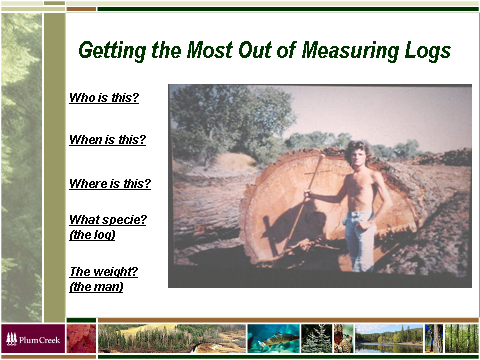
|
|
Timber industry economic
forecast – Henry Spelter, USFS Forest Products Laboratory,
Madison,
Wisconsin. Henry showed us the importance of U.S.
single
family housing starts for wood products demand and illustrated its
precipitious
decline over the past three years. Its collapse, down about 60% since
2001,
contributed to the disappearance of one third of the North American
market for
solid wood products. Beginning around 2001, housing prices
increased at a
much faster rate than incomes and this, together with liberal lending
practices
(such as variable rate loans), created an environment where many new
home
buyers suddenly found themselves unable to make mortgage payments when
interest
rates began to climb in 2005. From their peaks lumber prices have
dropped 30%
and OSB 50%. Log prices, however, have dropped at a slower rate than
prices for
wood products, which has put mills under severe financial pressure. The
only
good news, which is mixed, is that the trade deficit has started to
drop as a
result of the weaker dollar. View the presentation.
|
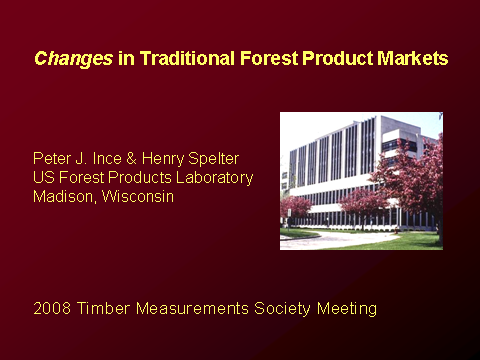
|
|
Wood fiber - reductions in saw mill
residues,
increased chip and hogged fuel price volatility and meeting supply
needs for
pulp, reconstituted panels and the growing biofuels market. - Mark Kendall, Oregon Department of
Energy, Salem, Oregon. Mark gave
us an overview of the current markets and policy changes that are
driving
demand for biofuels. These included the move to mitigate potential for
large
wildfires, the current high costs for fossil fuels, and the desire to
reduce
greenhouse gases. In Oregon
there is 50 million dollars of investment in cellulosic alcohol
production.
Within 7-10 years, Mark predicts that there will be more money made
from carbon
sequestration than will be made from wood products. Forest
slash is an area where there is the greatest potential to increase
biomass
production. View
the presentation.
|

|
|
New Allegro MX hand-held data
recorder and log scaling
and cruising software for handhelds that predicts primary and secondary
products recovery – David Dean, Electronic
Data Solutions, Jerome, Idaho and Matt
Fonseca, UNECE, Geneva Switzerland. David
presented the new Juniper Systems Allegro MX, which uses Windows Mobile
Six. It
is faster than the previous model and has built in wifi and bluetooth.
David
was scheduled to show a program that he and Matt Fonseca have been
working on;
however there was not time to put the test program into a handheld
format. Matt
Fonseca showed the excel version of the program, which if setup
properly will
predict product output, in primary products (lumber, plywood, veneer,
pulp
chips) and secondary products (chips, sawdust, shavings, peeler cores,
etc.).
It is also setup so that if a mill produces several products; e.g.,
studs out
of small logs; boards, dimension lumber or veneer out of big logs; the
program
will separate these products (when the scaler indicates end-use by
type) and
the volumes of the primary and secondary products will be totaled. The
program
has default recovery values that are “typical” but
is also tunable to
individual operations. View the
presentation. View a data example.
|
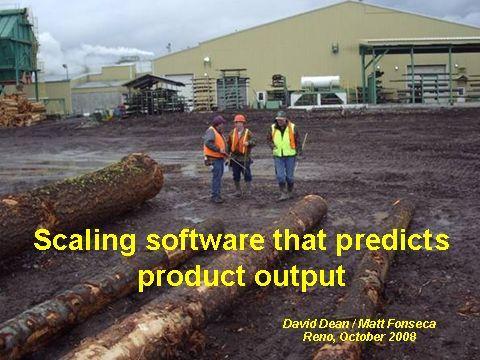 |
|
New Idaho log scaling manual
– Ernie Bauer, Idaho Board
of Scaling Practices, Coeur d’Alene, Idaho. Ernie covered the history of the Idaho
scaling handbook. The first handbook,
vocational education (VoEd) #38 was produced in the 1960s. In 1974 it
was
revised and widely used. In 1985 the orange USFS handbook was published
and
this became the standard for scaling in Idaho.
When the orange USFS handbook went out of print, the decision was made
to
develop a new scaling manual as a ready reference of Idaho scaling
standards
rather than depend on an out of print handbook. Ernie walked us through
the
various chapters and features of the handbook. Ernie then went on to
show the
various areas where IBSP scaling standards have been modified
introduced or
clarified. The manual is available on the IBSP website.
View the
presentation.
|
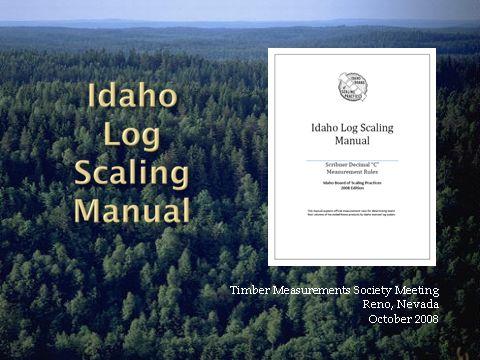 |
|
USFS strategies for measuring
low-valued roundwood and
biomass - Ken Cormier, Forest Measurements Service Center,
USFS, Fort Collins,
Colorado.
Ken defined the USFS
definition of woody biomass. Despite its low value, they still need to
know
volumes. 3P remote sensing is a method that is low cost and has proven
very
useful. Pile estimation is being studied as is fix count, which can be
used to
derive tons. They are currently reviewing and validating these methods,
as
there has been little work done on this in the past. Randomized branch
sampling
is one method used to measure branch and foliage weights and importance
sampling appears to be a promising method for bole wood. View the
presentation.
|
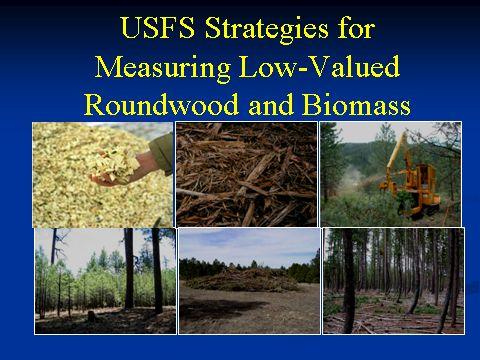 |
Advanced log scanners –
Ludwig Fleischhackl, Microtec,
Salmon Arm, B.C and Brixen, Italy.
MiCROTEC is a European
company that continuously invests in Research & Development of state
of the art scanning systems and automation solutions. The goal of MiCROTEC is to offer highly accurate, calibrated and
integrated solutions to optimize sawmill equipment, scale volume and maximize
recovery. TOMOlog maps accurately knots, detects metal and defines bark from
wood with feed speeds up to 780 feet per minute. SCREENlog + adds high
resolution image processing with the objective to build a data file system
where to archive 3D images of the logs with respective information about
geometrical dimensions and quality for further review in case of need. ViSCAN
for logs allows predicting stiffness with accurate precision. CT.log is an
advanced prototype of the world wide first computer tomography for logs and is
implemented presently in Germany.
The aim is to deliver extreme detail richness likely to a crystal clear view
inside the log at high conveyor speeds. The CT.log will be used for clear grade
assessment, for easily separating wood volume from bark and, above all, to
deliver the incredible opportunity for optimizing the log (and lumber) based on
knowing where and how large internal characteristics are, such as limbs, decay
and shake. Given the tremendous amount of data, this product is waiting on
computer processing that can formulate it under production conditions. View
the presentation.
|
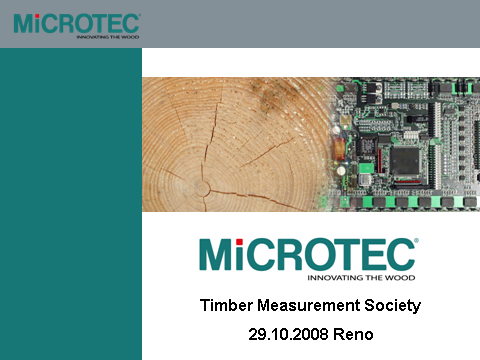 |
|
How to determine what a log is
worth: Modeling
break-even log values – Matt Fonseca, Timber Section, UNECE, Geneva.
Switzerland. Matt gave an introduction on how
to use sales price
for lumber and residuals, recovery and manufacturing cost to calculate
what a
log is worth. He went on further to show how to use mill studies to
determine
average product values and use these to build a product matrix in order
to
value lumber (or veneer) by diameter class, grade, species, etc. He
also showed
how to model manufacturing costs using production rates by diameter or
dimensions for size sensitive processes, e.g., primary log breakdown
vs. the
drying costs. He strongly suggested using cubic log volumes for the
model and
then convert to mbf or tons as a final step. View the
presentation.
|
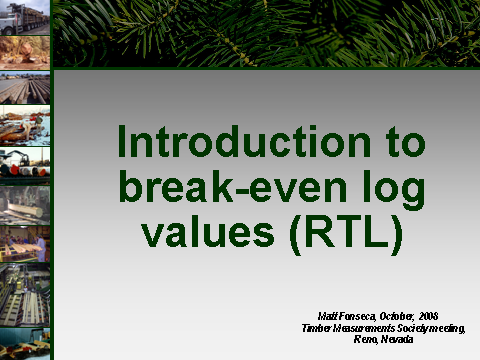 |
Some pictures
|
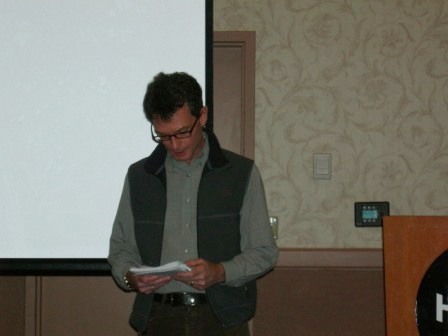 |
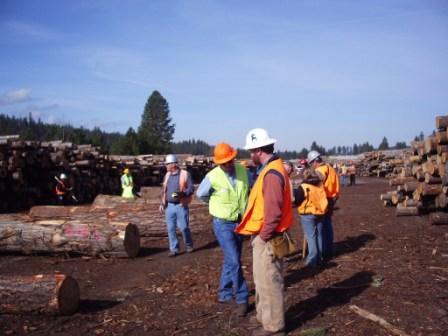 |
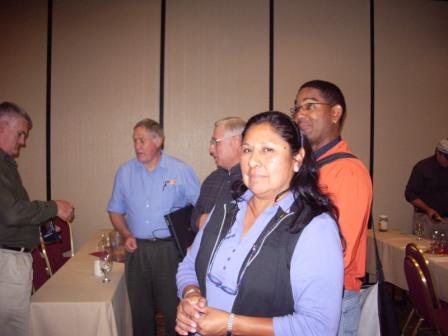 |
 |
| Chairman, Matt Fonseca |
Vice-chairman, Dennis Moore (in green) |
Secretary-treasurer, Thelma Alsup |
Scott Dodson |
|
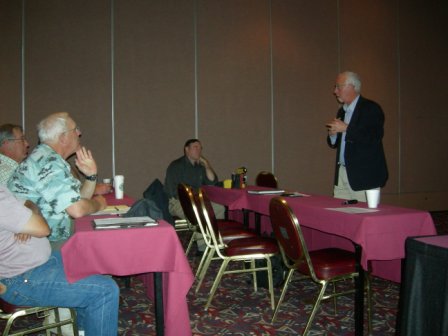 |
 |
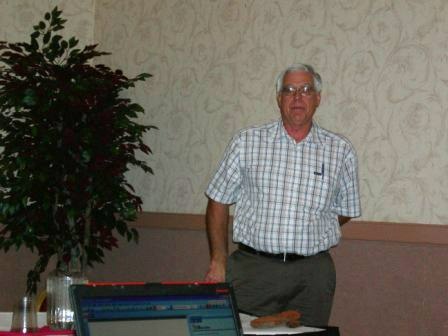 |
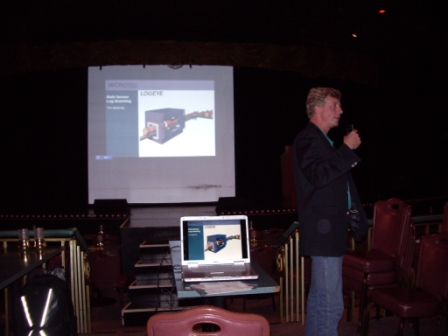 |
| Christian Paccot |
Jon Aschenbach |
Ken Lovelady |
Ludwig Fleischhackl |
|
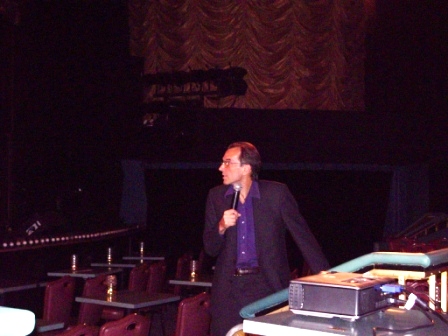 |
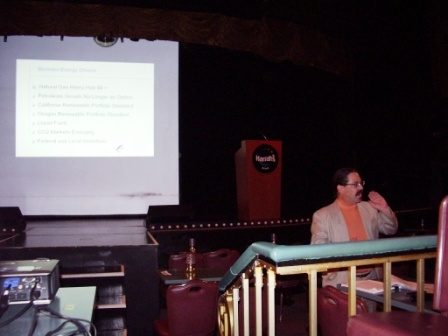 |
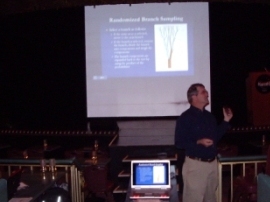
|
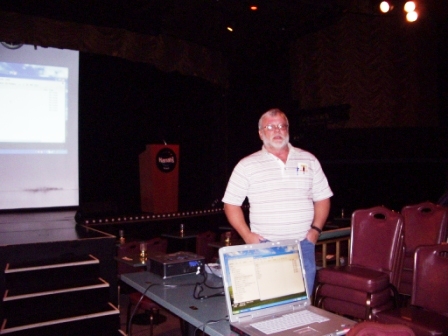 |
| Henry Spelter |
Mark Kendall |
Ken Cormier |
David Dean |
|
|
|
|
 |
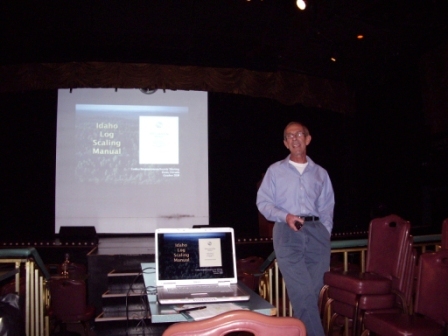 |
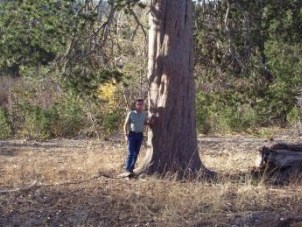 |
 |
| Cliff Lengstorf |
Ernie Bauer |
Huge lodgepole pine 40 miles west of Reno |
Meeting room on day-two (not the best) |
|
|

















